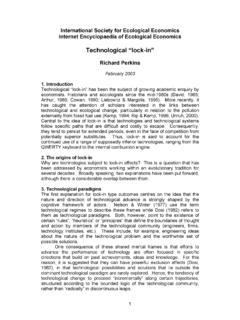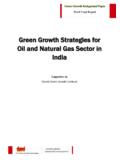Transcription of The Environmental Kuznets Curve
1 International Society for Ecological EconomicsInternet Encyclopaedia of Ecological EconomicsThe Environmental Kuznets CurveDavid I. SternDepartment of Economics, Rensselaer Polytechnic Institute, Troy, NY 12180,USAJune Environmental Kuznets Curve is a hypothesized relationship between variousindicators of Environmental degradation and income per capita. In the earlystages of economic growth degradation and pollution increase, but beyond somelevel of income per capita (which will vary for different indicators) the trendreverses, so that at high-income levels economic growth leads to environmentalimprovement. This implies that the Environmental impact indicator is an invertedU-shaped function of income per capita. Typically the logarithm of the indicator ismodeled as a quadratic function of the logarithm of income. An example of anestimated EKC is shown in Figure 1. The EKC is named for Kuznets (1955) whohypothesized income inequality first rises and then falls as economicdevelopment EKC is an essentially empirical phenomenon, but most of the EKCliterature is econometrically weak.
2 It is very easy to do bad econometrics and thehistory of the EKC exemplifies what can go wrong. The EKC idea rose toprominence because few paid sufficient attention to econometric diagnosticstatistics. Little or no attention has been paid to the statistical properties of thedata used such as serial dependence or stochastic trends in time series and fewtests of model adequacy have been carried out or presented. However, one ofthe main purposes of doing econometrics is to test which apparent relationships,or "stylized facts", are valid and which are spurious we do take such statistics into account and use appropriatetechniques we find that the EKC does not exist (Perman and Stern 2003).Instead we get a more realistic view of the effect of economic growth andtechnological changes on Environmental quality. It seems that most indicators ofenvironmental degradation are monotonically rising in income though the"income elasticity" is less than one and is not a simple function of income related effects reduce Environmental impacts in countries at all levels ofincome.
3 However, in rapidly growing middle income countries the scale effect,which increases pollution and other degradation, overwhelms the time effect. Inwealthy countries, growth is slower, and pollution reduction efforts can overcomethe scale effect. This is the origin of the apparent EKC econometric results are supported by recent evidence that, in fact,pollution problems are being addressed and remedied in developing economies( Dasgupta et al., 2002).This article follows the development of the EKC concept in approximatelychronological order. Sections 2 and 3 of the article review in more detail thetheory behind the EKC and the econometric methods used in EKC 4 through 6 review some EKC analyses and their critique. Sections 7discusses the recent evidence from Dasgupta et al. and others that has changedthe picture that we have of the EKC. The final two sections discuss an alternativeapproach - decomposition of emissions - and summarize the BackgroundThe EKC concept emerged in the early 1990s with Grossman and Krueger s(1991) pathbreaking study of the potential impacts of NAFTA and Shafik andBandyopadhyay s (1992) background study for the 1992 World DevelopmentReport.
4 However, the idea that economic growth is necessary in order forenvironmental quality to be maintained or improved is an essential part of thesustainable development argument promulgated by the World Commission onEnvironment and Development (1987) in Our Common EKC theme was popularized by the World Bank s World DevelopmentReport 1992 (IBRD, 1992), which argued that: The view that greater economicactivity inevitably hurts the environment is based on static assumptions abouttechnology, tastes and Environmental investments (p 38) and that As incomesrise, the demand for improvements in Environmental quality will increase, as willthe resources available for investment (p 39). Others have expounded thisposition even more forcefully with Beckerman (1992, p 482) claiming that thereis clear evidence that, although economic growth usually leads to environmentaldegradation in the early stages of the process, in the end the best and probablythe only way to attain a decent environment in most countries is to becomerich.
5 However, the EKC has never been shown to apply to all pollutants orenvironmental impacts and recent evidence (Dasgupta et al., 2002; Perman andStern, 2003) challenges the notion of the EKC in general. The remainder of thissection discusses the economic factors that drive changes in environmentalimpacts and may be responsible for rising or declining Environmental degradationover the course of economic there were no change in the structure or technology of the economy,pure growth in the scale of the economy would result in a proportional growth inpollution and other Environmental impacts. This is called the scale effect. Thetraditional view that economic development and Environmental quality areconflicting goals reflects the scale effect alone. Proponents of the EKChypothesis argue that at higher levels of development, structural changetowards information-intensive industries and services, coupled with increasedenvironmental awareness, enforcement of Environmental regulations, bettertechnology and higher Environmental expenditures, result in leveling off andgradual decline of Environmental degradation.
6 (Panayotou, 1993, p 1).Therefore, at one level the EKC is explained by the following proximate factors of production implies expanding production at given factor-inputratios, output mix, and state of industries have different pollution intensities and typically, overthe course of economic development the output mix in input mix involve the substitution of less environmentallydamaging inputs for more damaging inputs and vice in the state of technology involve changes in both:a. Production efficiency in terms of using less, ceteris paribus, of thepolluting inputs per unit of specific changes in process result in less pollutant beingemitted per unit of proximate variables may in turn be driven by changes in underlyingvariables such as Environmental regulation, awareness, and education in thecourse of economic development. A number of papers have developedtheoretical models about how preferences and technology might interact to resultin different time paths of Environmental quality.
7 The different studies makedifferent simplifying assumptions about the economy. Most of these studies cangenerate an inverted U shape Curve of pollution intensity but there is noinevitability about this. The result depends on the assumptions made and thevalue of particular parameters. Lopez (1994) and Selden and Song (1995)assume infinitely lived agents, exogenous technological change and thatpollution is generated by production and not by consumption. John andPecchenino (1994), John et al. (1995), and McConnell (1997) develop modelsbased on overlapping generations where pollution is generated by consumptionrather than by production activities. Stokey (1998) allows endogenous technicalchange. It seems fairly easy to develop models that generate EKCs underappropriate assumptions but none of these theoretical models has beenempirically tested.
8 Furthermore, if in fact the EKC for emissions is monotonic asmore recent evidence suggests, the ability of a model to produce an inverted U-shaped Curve is not necessarily a desirable FrameworkThe earliest EKCs were simple quadratic functions of the levels of , economic activity inevitably implies the use of resources and by thelaws of thermodynamics, use of resources inevitably implies the production ofwaste. Regressions that allow levels of indicators to become zero or negative areinappropriate except in the case of deforestation where afforestation can restriction can be applied by using a logarithmic dependent variable. Thestandard EKC regression model is:ln(E/P)it = i + t + 1 ln(GDP/P)it + 2 (ln(GDP/P))2it + it(1)where E is emissions, P is population, and ln indicates natural logarithms. Thefirst two terms on the RHS are intercept parameters which vary across countriesor regions i and years t.
9 The assumption is that though the level of emissions percapita may differ over countries at any particular income level the incomeelasticity is the same in all countries at a given income level. The time specificintercepts are intended to account for time varying omitted variables andstochastic shocks that are common to all the model is estimated with panel data. Most studies attempt toestimate both the fixed effects and random effects models. The fixed effectsmodel treats the i and t as regression parameters while the random effectsmodel treats them as components of the random disturbance. If the effects i and t and the explanatory variables are correlated, then the random effects modelcannot be estimated consistently (Mundlak, 1978; Hsiao, 1986). Only the fixedeffects model can be estimated consistently. A Hausman (1978) test can be usedto test for inconsistency in the random effects estimate by comparing the fixedeffects and random effects slope parameters.
10 A significant difference indicatesthat the random effects model is estimated inconsistently, due to correlationbetween the explanatory variables and the error components. Assuming thatthere are no other statistical problems, the fixed effects model can be estimatedconsistently, but the estimated parameters are conditional on the country andtime effects in the selected sample of data (Hsiao, 1986). Therefore, they cannotbe used to extrapolate to other samples of data. This means that an EKCestimated with fixed effects using only developed country data might say littleabout the future behavior of developing countries. Many studies compute theHausman statistic and finding that the random effects model cannot beconsistently estimated estimate the fixed effects model. But few have ponderedthe deeper implications of the failure of this orthogonality and Stern (2003) employ some newly developed panel unit rootand cointegration tests and find that sulfur emissions and GDP per capita may beintegrated variables.






